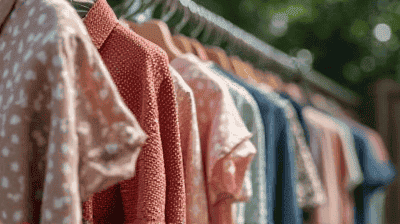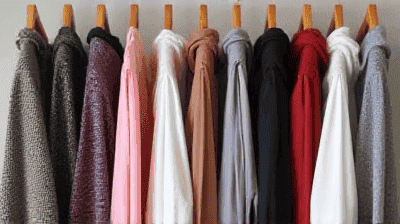
The fashion industry is one of the most resource-intensive sectors in the world, contributing significantly to global textile waste and environmental degradation. With increasing awareness of the negative impacts of fast fashion, many brands are beginning to adopt circular business models aimed at minimizing waste and promoting sustainability. Circular fashion encourages the design, production, and consumption of clothing in a way that prioritizes resource efficiency and environmental responsibility.
The scale of textile waste is staggering. According to the Environmental Protection Agency (EPA), millions of tons of textile waste are generated annually, with a significant portion ending up in landfills. The fashion industry is responsible for around 10% of global carbon emissions, and every second, the equivalent of one garbage truck of textiles is landfilled or incinerated. The linear model of fashion, characterized by a "take, make, dispose" approach, has led to unsustainable practices that contribute to significant environmental harm.
Textile waste encompasses a variety of materials and products, including:
Each type of waste presents unique challenges for waste management and recycling.

Circular fashion is part of the larger concept of a circular economy, which emphasizes the continual use of resources and the elimination of waste. In a circular fashion model, products are designed with their end-of-life in mind, enabling them to be repurposed, recycled, or reused rather than discarded.
Key principles of circular fashion include:
Brands adopting circular models can experience several advantages:
Many fashion brands are shifting toward using sustainable materials that can be recycled or have a lower environmental impact. Examples include:
Recycled Materials: Brands like Adidas are integrating recycled plastic waste from oceans and landfills into their products, reducing reliance on virgin materials. Their "Parley for the Oceans" initiative exemplifies this approach.
Organic Fibers: Companies such as Patagonia use organic cotton and eco-friendly fibers, which require less water and no harmful pesticides, thereby reducing the environmental footprint of their production.
Innovative Fabrics: Brands like Stella McCartney are investing in innovative materials such as Mylo, a mushroom-based leather alternative, to provide sustainable options that do not compromise on quality.
Managing the lifecycle of a product is key to circular fashion. Brands are now looking to extend the life of their products through various strategies:
Timeless Design: Fashion labels like Eileen Fisher emphasize classic designs that transcend trends, encouraging consumers to invest in timeless pieces that they will keep for years.
Repair Services: Brands such as Nudie Jeans offer repair programs to mend damaged clothing, promoting the idea of keeping products in use longer rather than discarding them.
Take-Back Initiatives: Many companies are implementing take-back programs, where consumers can return unwanted items for recycling or resale. For example, H&M has introduced a garment collection initiative that encourages customers to bring back any used clothing, regardless of brand.
Upcycling and recycling are effective ways to divert textile waste from landfills and create new products:
Upcycling: Brands like Reformation focus on upcycling surplus materials and post-consumer waste into new garments. This creative approach not only reduces waste but also adds unique character to each piece.
Recycling Technologies: Companies such as The North Face and Adidas are investing in advanced recycling technologies that break down materials into their original fibers for reuse in new products, closing the loop on textile waste.
Fashion brands are exploring innovative business models to support circularity:
Rental Services: Brands like Rent the Runway and My Wardrobe HQ offer rental services for clothing and accessories, allowing consumers to enjoy high-quality fashion without the burden of ownership. This model promotes reusability and reduces demand for new products.
Subscription Services: Services like Le Tote provide subscription-based clothing rentals, enabling consumers to stay stylish while minimizing their fashion footprint. Customers can return items after wearing them, promoting continuous circulation of garments.
Second-Hand Marketplaces: Platforms like Poshmark and Depop facilitate the buying and selling of second-hand clothing, encouraging consumers to extend the life cycle of garments and reducing textile waste.
Educating consumers about sustainable practices and the value of circular fashion is vital to its success. Brands are using various strategies to engage and inform their customer base:
Transparency: Brands like Everlane practice transparency by showing consumers the true cost of production, highlighting ethical sourcing, and promoting sustainable practices.
Storytelling: Many brands are utilizing storytelling to connect with consumers and showcase the journey of their products from production to disposal. This helps foster a sense of responsibility among consumers.
Workshops and Events: Organizing events and workshops focused on sustainability, upcycling, and repair skills can empower consumers and strengthen community ties around circular practices.

Despite the many benefits of circular fashion, there are challenges that brands face when trying to adopt these models:
Transitioning to circular practices often requires a complete overhaul of supply chains. Establishing reliable sources for sustainable materials, upcycling, and recycling can be complex and resource-intensive. Brands must navigate partnerships with suppliers, manufacturers, and recycling facilities to create a seamless circular process.
Changing consumer habits and mindsets is essential for the success of circular fashion. Many consumers still prioritize convenience, fast fashion, and affordability over sustainability. Brands will need to invest in marketing and education efforts to shift consumer perceptions and encourage responsible consumption.
While some regulations support sustainable practices, others can hinder the adoption of circular models. Navigating varying regulations on waste management, recycling, and textile production can be complicated for brands operating in multiple markets.
Investing in sustainable materials, advanced recycling technologies, and circular business models can require significant upfront costs. While these investments can lead to cost savings in the long run, the initial financial burden may deter brands from making the shift.
The development of new sustainable materials and recycling technologies is still ongoing. Brands may face limitations in terms of available solutions that meet their performance and aesthetic standards.
Patagonia is a pioneer in sustainable fashion, with a strong commitment to environmental responsibility. The brand has implemented several circular initiatives, including:
Worn Wear Program: This program encourages customers to repair and recycle their clothing, offering an online marketplace for second-hand Patagonia items.
Recycled Materials: The brand uses recycled polyester and organic cotton in its products, contributing to a reduction in resource consumption and waste.
Transparency: Patagonia’s “Footprint Chronicles” provide consumers with information about the brand’s supply chain, encouraging informed purchasing decisions.
Stella McCartney is known for her commitment to sustainable luxury fashion. Key initiatives include:
Innovative Materials: The brand utilizes eco-friendly materials like vegan leather and organic cotton, reducing reliance on non-renewable resources.
Circular Design: McCartney’s collections prioritize design for longevity, promoting durable and timeless pieces that withstand trends.
Partnerships: The brand collaborates with organizations like the Ellen MacArthur Foundation to promote circularity in fashion and raise awareness about sustainability.
H&M has taken significant steps toward sustainability through its various initiatives:
Garment Collection Program: H&M collects unwanted clothing from customers, regardless of the brand, and recycles or resells the items to reduce textile waste.
Conscious Collection: The brand’s Conscious Collection features garments made from sustainable materials, offering eco-friendly alternatives to traditional fast fashion.
Transparency Goals: H&M aims to be transparent about its supply chain and sustainability efforts, providing consumers with information about the brand’s practices.
Eileen Fisher emphasizes sustainability as a core value, with initiatives that include:
Renew Program: The Renew Program encourages customers to return used Eileen Fisher clothing for resale or recycling, extending the life cycle of garments.
Organic and Sustainable Materials: The brand prioritizes the use of organic fibers and sustainable fabrics, significantly reducing the environmental impact of its production process.
Social Responsibility: Eileen Fisher advocates for fair labor practices and social responsibility throughout its supply chain.

The future of circular fashion will likely see advancements in technology that support recycling and sustainable production. Innovations in materials science, recycling processes, and manufacturing techniques can help create more efficient systems for managing textile waste.
To fully realize the potential of circular fashion, collaboration between brands, manufacturers, and stakeholders will be essential. Working together, industry players can share knowledge, resources, and best practices to advance sustainability.
Supportive policies and regulations can further drive the adoption of circular practices in the fashion industry. Governments can enact stricter guidelines on waste management and incentivize sustainable production methods.
As awareness of the environmental impacts of fast fashion grows, consumers are increasingly demanding sustainable options. The shift toward responsible consumption is likely to continue, driving brands to adapt and innovate.
To demonstrate the effectiveness of circular initiatives, brands will need to develop methods for measuring the environmental impact of their practices. Establishing clear metrics will help track progress and communicate results to consumers.
The future of fashion lies in embracing circular models that prioritize sustainability, resource efficiency, and waste reduction. As brands adopt innovative practices to mitigate textile waste, they contribute to a more sustainable industry and encourage consumers to rethink their purchasing habits.
While challenges remain, the fashion industry is at a pivotal moment where the adoption of circular practices may lead to transformative change. By integrating sustainable materials, supporting recycling initiatives, and engaging consumers, fashion brands can reduce their impact on the environment and pave the way for a more circular economy.
Every individual, from designers to consumers, plays a role in this transition. By supporting brands that prioritize sustainability and making conscious choices, we can collectively work towards a fashion industry that respects the planet and promotes responsible consumption for future generations.